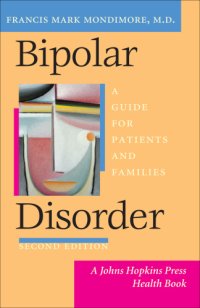
Ebook: Bipolar disorder: a guide for patients and families
Author: Mondimore Francis Mark
- Tags: Bipolar Disorder, Bipolar Disorder--therapy, Manic-depressive illness, PSYCHOLOGY--Psychopathology--Bipolar Disorder, SELF-HELP--Mood Disorders, Affective disorders, Electronic books, Popular works, Manic-depressive illness -- Popular works, Affective disorders -- Popular works, SELF-HELP -- Mood Disorders, PSYCHOLOGY -- Psychopathology -- Bipolar Disorder, Bipolar Disorder -- Popular Works, Bipolar Disorder -- therapy -- Popular Works
- Series: Johns Hopkins Press health book
- Year: 2006
- Publisher: Johns Hopkins University Press
- City: Baltimore
- Edition: 2nd ed
- Language: English
- epub
pt. IV. Getting better and staying well -- 20. Living with bipolar disorder -- Confront and accept the illness -- Practice mood hygiene -- Build your support system -- Don't be a "bipolar victim" -- 21. Planning for emergencies -- Know whom to call for help -- Insurance issues -- Safety issues and hospitalization -- 22. The role of family -- Recognizing symptoms -- Involuntary treatment and other legal issues -- More on safety -- Getting support -- 23. Looking ahead.;pt. II. Treatment -- 5. The brain : neurons, neurotransmitters, and more -- 6. Mood-stabilizing medications -- Lithium -- Valproate (Depakote, Depakene, Epival) -- Carbamazepine (Tegretol, Equetro, Epitol) -- Oxcarbazepine (Trileptal) -- Lamotrigine (Lamictal) -- Other mood stabilizers -- 7. Antidepressant medications -- Tricyclic antidepressants -- Selective serotonin reuptake inhibitors (SSRIs) -- Other new antidepressants -- Monoamine oxidase inhibitors (MAOIs) -- Treating bipolar depression -- 8. Antipsychotic medications -- The typical antipsychotic medications -- Atypical antipsychotic medications -- 9. Other medications, hormones, and dietary supplements -- Benzodiazepine medications -- Calcium-channel-blocking agents -- Stimulant medications -- Thyroid hormones -- St. John's wort -- Omega-3 fatty acids and fish oil -- 10. Electroconvulsive therapy and related treatments -- Modern ECT -- ECT for bipolar disorder -- Transcranial magnetic stimulation -- Vagal nerve stimulation -- 11. Counseling and psychotherapy -- Brain and mind -- What can therapy do? -- Group psychotherapy -- Individual therapy for depression -- New psychotherapies for bipolar disorder -- "Traditional" individual psychotherapy -- Psychotherapy in bipolar disorder : is it really necessary? -- The psychiatrist-psychotherapist : an extinct species? -- 12. Treatment approaches in bipolar disorder -- Therapeutic results as a guide to treatment -- A few principles of treatment.;Annotation Bipolar disorder can be devastating. It can disrupt relationships and careers, it can wreak havoc on family life, and, when not properly treated, it can be fatal. Since 1999 this compassionate and comprehensive guide has helped tens of thousands of people cope with this complex disease. This, the second edition of Bipolar Disorder, is thoroughly updated and discusses promising new options for diagnosis and treatment along with new information on the disease's genetic components. Bipolar disorder is difficult to diagnose. Dr. Mondimore explains how symptoms fluctuate in persons with seasonal affective disorder, how they can lead to a mistaken diagnosis of attention deficit & ndash;hyperactivity disorder in children, and how they may be made worse by alcohol or drug addiction. The disease can also be difficult to treat. Dr. Mondimore gives advice about how to pick a psychiatrist and cope with the stigma of psychiatric diagnosis. He provides extensive information on treatment options, including the advantages, disadvantages, and side effects of various drug therapies. He also describes what it is like to live with bipolar disorder and discusses how lifestyle changes can improve quality of life. Throughout, he focuses on the importance of building a support system, planning for emergencies, and giving yourself permission to seek help.;pt. I. Symptoms, syndromes, and diagnosis -- 1. Normal and abnormal mood -- Abnormal mood -- The manic syndrome -- The hypomanic syndrome -- The syndrome of depression -- Mixed states -- 2. The diagnosis of bipolar disorder -- Psychiatric diagnosis -- Bipolar I -- Bipolar II -- Cyclothymic disorder -- Bipolar spectrum disorders -- Rapid-cycling bipolar disorder -- Schizoaffective disorder -- 3. A summary of the diagnostic categories of bipolar disorder in DSM IV -- What is the DSM? -- A "multiaxial" diagnostic system -- Bipolar categories in DSM IV -- 4. The mood disease -- Before "bipolar" -- Dr. Kraepelin and "manic-depressive insanity" -- Dr. Cade and lithium.;pt. III. Variations, causes, and connections -- 13. Bipolar disorder in children and adolescents -- Symptoms of pediatric bipolar disorder -- Bipolar disorder and ADHD -- Treatment and prognosis -- 14. Women with bipolar disorder : special considerations -- Premenstrual syndromes -- Symptom differences in women -- Postpartum mood disorders and family planning -- 15. Alcoholism and drug abuse -- Bipolar binges -- Effect, cause, or association? -- Use or abuse? -- A deadly combination -- 16. Seasonal affective disorder and chronobiology -- Biological clocks -- Seasonal affective disorder -- The sleep cycle and bipolar disorder -- 17. The genetics of bipolar disorder -- Genes, chromosomes, and DNA -- Genetic diseases -- What we know -- The search continues -- 18. Bipolar biology -- "Medical" mood disorders -- Post-stroke mood disorders -- Mood disorders due to hormonal problems -- Picturing bipolar disorder in the brain -- Viruses and bipolar disorder -- 19. Bipolar disorder and creativity.
Download the book Bipolar disorder: a guide for patients and families for free or read online
Continue reading on any device:

Last viewed books
Related books
{related-news}
Comments (0)